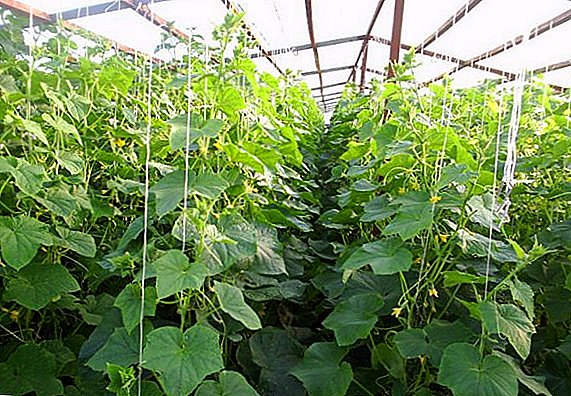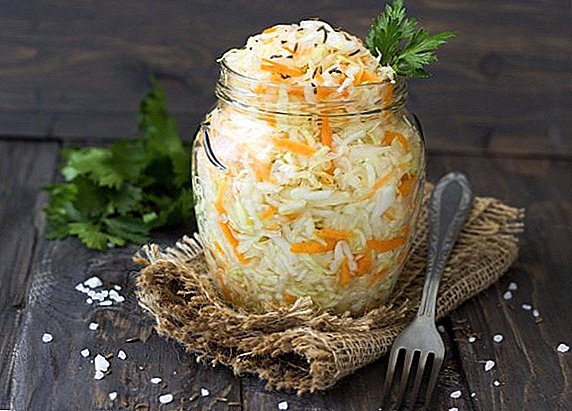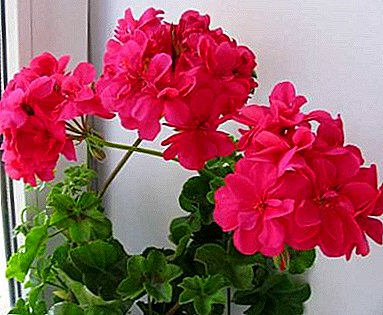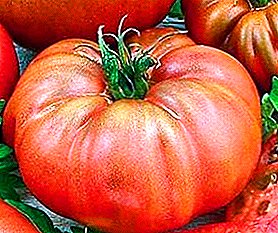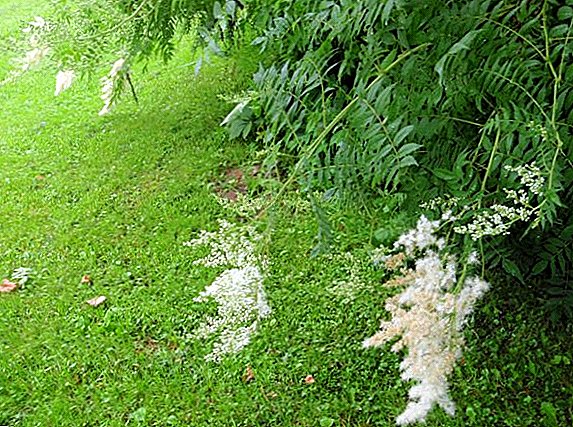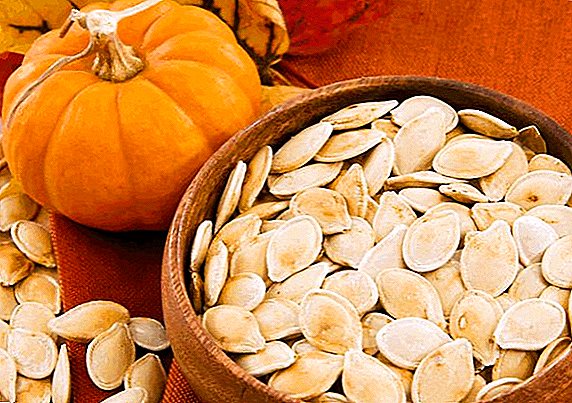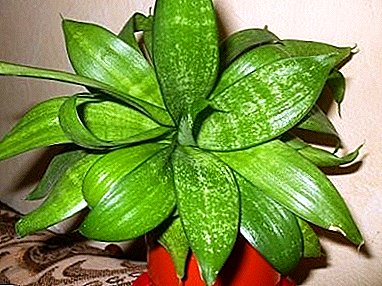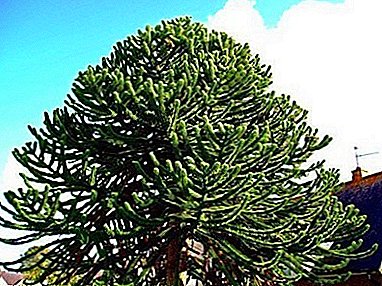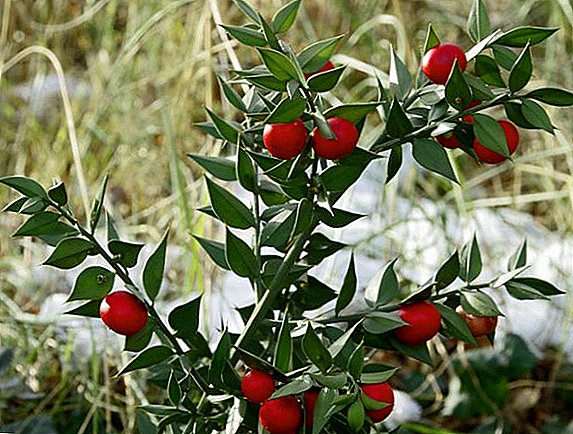 Iglitsa is a perennial shrub in the wild; it is found in the wild in the pine and oak forests of Western Europe, in the arrays of the Crimea and the Caucasus, in North Africa and some Asian countries.
Iglitsa is a perennial shrub in the wild; it is found in the wild in the pine and oak forests of Western Europe, in the arrays of the Crimea and the Caucasus, in North Africa and some Asian countries.
Brief Description of Culture
Iglitsa or Ruscus (lat. Ruscus, Eng. Butcher's broom), a plant of the Asparagaceae family (lat. Asraragaseae), was relatively recently attributed to its own Iglitse family (Latin Rossaceae), Lileae (lat. Liliasee) or Landyshev (lat. Convarda).
Did you know? Iglitsa grew on our planet in the preglacial period and is considered to be a relict plant. Today it is not widespread and does not even have a dozen species. Nevertheless, the unusual Ruscus is found in the interiors of homes and offices, in the garden plots of regions with a mild climate.The few plant species vary in size and appearance. Some of them are grown in gardens (such as sublingual or Italian iglitsa (Latin: Ruscus hypoglossum), mischievous iglitsa (Latin. Ruscus hypophyllum), and hyrcanic iglitz (Latin. Rúscus hyrcanus); (lat. Ruscus aculeatus).
 Evergreen shrubs, dwarf shrubs or perennial grass, with characteristic upright or drooping woody stems that depart from the creeping rhizomes.
Evergreen shrubs, dwarf shrubs or perennial grass, with characteristic upright or drooping woody stems that depart from the creeping rhizomes.Depending on the species, they can reach lengths from 30 cm to 1 m. Shoots-filloclades that take the form of leaves have a leathery, tough, matte or glossy structure, an ovate lanceolate form with rounded or sharp ends, and a rich green color. The length of the shoots can reach 11 cm and width 2-6 cm.
The leaves of iglitsa are also quite unusual, they look like small translucent film-covered scales, triangular in shape. Small, inconspicuous flowers of pale blue, white or greenish-purple hue, forming on the phylloclades, have a fairly long flowering period.  After flowering, bright round red-orange fruits with 2-3 seeds are formed, giving Ruscus a special decorative effect.
After flowering, bright round red-orange fruits with 2-3 seeds are formed, giving Ruscus a special decorative effect.
It is difficult to imagine a summer cottage without berry bushes, which not only decorate the landscape, but also delight you with tasty healthy fruits. Among them: edible honeysuckle, blueberry, currant, gooseberry, blackberry, cranberry.
Chemical composition and active substances
The needle plant has its irreplaceable healing properties due to its chemical composition:
- squirrels;
- fats;
- sucrose;
- vegetable fiber;
- vitamins C and PP;
- trace elements: calcium, magnesium, iron, potassium, silicon, cobalt, manganese, phosphorus, chromium, aluminum.
 The active substances concentrated mainly in the rhizome are saponosides (such as ruskogenin) and heterosides (for example, rutoside).
The active substances concentrated mainly in the rhizome are saponosides (such as ruskogenin) and heterosides (for example, rutoside).Did you know? What kind of names does not carry a miraculous plant - Ruscus, mouse thorns, Colchian asparagus, royal broom, butcher's broom. From its fruits made beautiful bouquets, durable flexible brooms, coffee drink and even magic beads.
What is the useful needle?
Saponosides have a healing effect on the vessels of the veins. Ruscus as part of oral medication is used to constrict skin vessels.  Pontic (prickly) Iglitsa has healing properties aimed at eliminating the exacerbation of hemorrhoids, venous dysfunctions, manifested in premenstrual syndrome, pregnancy and oral contraceptive use. Drugs containing Ruscus are used for:
Pontic (prickly) Iglitsa has healing properties aimed at eliminating the exacerbation of hemorrhoids, venous dysfunctions, manifested in premenstrual syndrome, pregnancy and oral contraceptive use. Drugs containing Ruscus are used for:
- narrowing of the venous vessels;
- strengthen the venous walls;
- reduce the fragility and permeability of capillaries and vessel walls;
- improve the tone of smooth cellular muscles;
- improve cell metabolism;
- removal of slag from muscle tissue;
- stimulation of blood circulation and water-salt metabolism;
- obstacles to the formation of inflammatory processes;
- reduce blood clots.
 The plant in the composition of anti-cellulite products contributes to the activation of peripheral circulation and the restoration of skin elasticity.
The plant in the composition of anti-cellulite products contributes to the activation of peripheral circulation and the restoration of skin elasticity.Important! The medicinal plant has anti-inflammatory, firming, antimicrobial, cleansing, stimulating, diaphoretic, vasoconstrictor, diuretic and laxative properties.
Use in traditional medicine
In folk medicine, use the fruits and roots of the needle. Of them make ointments, decoctions, tinctures, extracts.
Healers use folk remedies to treat such diseases:
- jaundice;
- thrombosis;
- atherosclerosis;
- cardiovascular problems;
- headaches;
- phlebeurysm;
- gout;
- hemorrhoids;
- cramps;
- swelling;
- renal failure;
- inflammation of the gallbladder;
- gangrene;
- Meniere's disease;
- Alzheimer's disease;
- Raynaud's syndrome
Did you know? The plant got its popular name "butcher's broom" thanks to its use by butchers to clean cutting boards with the hard roots of the butcher, which have excellent anti-bacterial properties.
 At home, you can prepare such therapeutic mixtures of rhizomes of Ruscus:
At home, you can prepare such therapeutic mixtures of rhizomes of Ruscus:- Infusion diuretic, is also used for pain relief for PMS and varicose veins: in 1 liter of boiling water add 1 tbsp. spoonful of crushed dry root of the butcher, insist three hours and strain.
- Decoction for the treatment of seizures, lymphatic stasis, swelling of the legs and problems during menopause in women: in 1 liter of water add 60 g of rhizomes, boil and boil on low heat for 20 minutes.
For medicinal purposes, they also use parsnip root, kupeny, parsley, asparagus, sow thistle, elecampane, blackberry, Syrian syrup.
Contraindications and harm
Iglitsa has a huge range of medicinal properties, but it also has contraindications for use:
- inflammatory processes of the urinary tract;
- tendency to hypertension;
- gestation period.
Important! If there are symptoms of venous congestion, as well as with increased blood pressure, consult a doctor.

Non-compliance with the dosage of drugs containing Ruscus, can lead to rare side effects:
- stomach disorders;
- nausea.


